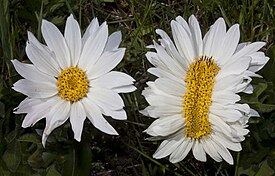
Back شمعلة Arabic Фасция Bulgarian Fasciació Catalan Fasciace Czech Verbänderung German Fascio (botaniko) Esperanto Fasciación Spanish Fastsiatsioon Estonian Fasciation French Fasiasi ID


Fasciation (pronounced /ˌfæʃiˈeɪʃən/, from the Latin root meaning "band" or "stripe"), also known as cresting, is a relatively rare condition of abnormal growth in vascular plants in which the apical meristem (growing tip), which normally is concentrated around a single point and produces approximately cylindrical tissue, instead becomes elongated perpendicularly to the direction of growth, thus producing flattened, ribbon-like, crested (or "cristate"), or elaborately contorted tissue.[1] Fasciation may also cause plant parts to increase in weight and volume in some instances.[2] The phenomenon may occur in the stem, root, fruit, or flower head.
Some plants are grown and prized aesthetically for their development of fasciation.[3] Any occurrence of fasciation has several possible causes, including hormonal, genetic, bacterial, fungal, viral and environmental causes.
- ^ White, Orland E. (1948). "Fasciation". The Botanical Review. 14 (6): 319–358. doi:10.1007/BF02861723.
- ^ Albertsen, Marc C.; Curry, Therese M.; Palmer, Reid G.; Lamotte, Clifford E. (1983). "Genetics and Comparative Growth Morphology of Fasciation in Soybeans (Glycine max [L.] Merr.)". Botanical Gazette. 144 (2): 263–275. doi:10.1086/337372. JSTOR 2474652. S2CID 84260097.
- ^ Morris, Scott. "Fasciation in Flowers – What You Need To Know". Gardentoolbox. Archived from the original on 10 January 2014. Retrieved 10 January 2014.
© MMXXIII Rich X Search. We shall prevail. All rights reserved. Rich X Search